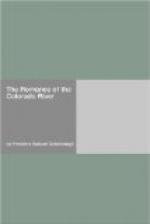CHAPTER XIII
A Canyon through Marble—Multitudinous Rapids—Running
the
Sockdologer—A Difficult Portage, Rising
Water, and a Trap—The Dean
Upside Down—A Close Shave—Whirlpools
and Fountains—The Kanab
Canyon and the End of the Voyage.
By referring to the relief map opposite page 41, the mouth of the Paria is seen a trifle more than half-way up the right-hand side. The walls of Glen Canyon here recede from the river and become on the south the Echo Cliffs, taking the name from the Echo Peaks which form their beginning, and on the north the Vermilion Cliffs, so called by Powell because of their bright red colour. The latter, and the canyon of the Paria, make the edges of the great mesa called the Paria Plateau, and, running on north to the very head of the Kaibab uplift, strike off south-westerly to near Pipe Spring, where they turn and run in a north-west direction to the Virgen River. Between the receding lines of these cliffs, at the Paria, is practically the head of the Grand Canyon. The river at once begins an attack on the underlying strata, and the resulting canyon, while at first not more than two hundred feet deep, rapidly increases this depth, as the strata run up and the river runs down. The canyon is narrow, and seen from a height resembles, as previously mentioned, a dark serpent lying across a plain. As the formation down to the Little Colorado is mainly a fine-grained grey marble, Powell concluded to call this division by a separate name, and gave it the title it now bears, Marble Canyon. There




